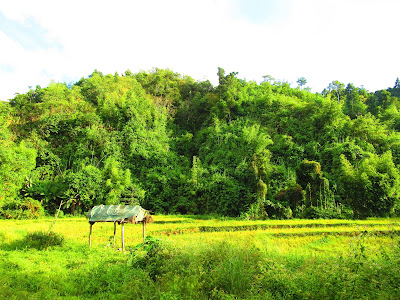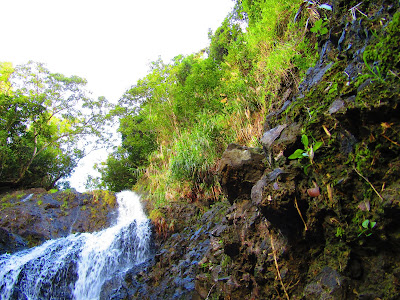Theme:
“Cagayan River: looking back at our past, nurturing the present and looking forward to the future”.
Synopsis:
Once an ally, two brave leaders in the East and West of the province had been in conflict for the rich valley land until the formation of Cagayan River brought them together again into peace, united as one.
THE LEGEND OF CAGAYAN RIVER
Once upon a time in a massive, rich, fertile “tanap” or valley, north of the so called Luzonia Island, there was a sprawling and bustling village called “Kaagayan” which means “the place where our friends live”. Its root word “Agay” was the term used by the villagers to call friends. It was ruled by a kind, generous and brave leader named Apo Daya.
Kaagayan was bounded by the mighty Cordillera mountains in the west and the enormous Sierra Madre range in the east. The prosperity of the village owed to the abundance of rain, the natural fertility of the valley soil, the richness of the mountains and forests and the blessing of their “anito” or deity named Kabunian, the god of good harvest.
Whenever harvest seasons begun, the villagers offered Kabunian a portion of their produce called “atang” as a sign of thanksgiving. The people were helping each other and there were no misunderstanding among them. Kabunian, the all-powerful deity was very happy to see how grateful and kind the people of Kaagayan and thus, made their “apit” or harvest always bountiful.
As days, months and years passed by, the village became more industrialized and grew forth in population. Parts of the once vast fertile lands were converted into residential places. This led to the decrease in harvest, aggravated by ‘tikag” or severe drought brought about by El Nino phenomenon during those times. As a result, there was an impending strike of famine.
To address the persisting problem, Apo Daya designated another leader to help him manage the difficulties the whole village was facing.
“We needed another great leader to help us overcome this crisis”,
lamented Apo Daya and so the wise leader appointed the courageous and fearless Apo Laud his “makannawan” or right hand to guide and manage the Western valley front of Kaagayan. The Eastern valley front was left for Apo Daya to preside over. As two heads were better than one, the populous village of Kaagayan became more powerful and progressive again as they developed new means to increase their harvest yield and looked for other ways to compensate for their ever-increasing needs.
Many years had passed; there was again a population spurt. The once village of Kaagayan became what is known today as a province. And so, much of the land and mountains have been decimated and cleared to build houses and roads. Harvests were so scanty as the valley land could not anymore produce enough food for the growing number of people.
The only remaining huge fertile land was located on the central part of the province lying between the colossal mountain ranges of the Cordilleras and the Sierra Madre.
“Let’s divide the central valley”,
suggested by the bright Apo Daya and so the two leaders have bilaterally agreed to divide the remaining rich land into two equal portion. The Cordilleras and the western side became the realm of Apo Laud. The eastern portion facing the Sierra Madre became the domain of Apo Daya.
The Sierra Madre mountain range was producing more rain as it faced the Pacific Ocean and thus, keeping the Eastern Kaagayan produce more harvest than the western counterpart of the province which was a little drier. This made Apo Laud thought that he was tricked. And so there was a rift or “riri” between the two great leaders.
“We have to make something about it as we are not producing enough food for our people. We were fooled as we have received the less productive land”,
complained Apo Laud as he explained the problem to his people. There was now a feeling of vengeance and greed to the people of Western Kaagayan and so they begun stealing the harvest of the people in the East. Not only that, they have crossed the boundary and invaded Eastern Kaagayan to get parts of the more productive soil.
This infuriated the great leader Apo Daya and so he declared “gubat” or war against the West. The conflict lasted for more years and since then claimed so many lives into the detriment of both sides. Because of this, life in the province became harder for all the people to bear.
For some time, there was a truce between the two fronts and one of the “panglakayen” or great sagacious elders named Lakay Kasiriban advised Apo Daya.
“Ask Kabunian for the needed help and so that peace shall ensure between his people, the once united, harmonious people of Kaagayan”,
the bearded wise elder told Apo Daya.
The brave leader agreed.
“Let us pray to the mighty Kabunian”, appealed by Apo Daya and so his people followed as advised. The people offered “atang”, knelt down and begun to pray.
Kabunian, the all-powerful deity was not happy about the rift between the people of Kaagayan whom he blessed with fertile land and good harvest.
And so in an instant, the sky darkened and the ground shook. The central valley cracked and ripped apart and there was a huge, long void. The crack was slowly filled with rainwater and springs oozed from the bottom of that deep rupture, persistent and long enough that the flowing water reached the end of the land into the north of Luzonia Island.
“This I made, a permanent partition from east to west and so rift between my people would not continue. I will keep the valley fertile, rich and productive though. This I say unto you my people, the waterway that will dampen your valley home and produce the largest food harvest in the entire land”,
Kabunian mightily said as his voice reached the land echoing in the entire valley. And so all of the sudden, an iconic “karayan” or river amid the vast Kaagayan Valley was already flowing leading northward to what is known today as the Babuyan channel.
And there was fear among the people witnessing in awe the enormous waterway meandering through amid the valley.
It was then that Apo Laud realized his mistakes and pleaded for the pardon of Kabunian.
The remorseful Apo Laud humbly conceded to their old great leader Apo Daya and so peace has been restored in the valley between the East and West of Kaagayan.
The two sides had now producing massive rice harvest and other major crops such as corn, peanuts and sugarcane, thanks to the great river that bisected the entire province in eastern and western half, irrigating both ways.
The river had gradually and strongly unified the two fronts of the east and west, known today as Districts 1 and 2 and so the province of Kaagayan later became “Cagayan” derived from “karayan” which would mean river; the river that brought fortune to the entire valley; the river that became the bloodline of the entire valley home of the people; the mighty river in Cagayan; none other than the Cagayan River.
Today, the people of Cagayan know the importance of the Cagayan River in their lives. It became a symbol of hope, unity and progress among the people. It is the life of the entire valley home that needs to be loved, protected and sustained as it played a major role in the development of the Cagayano’s rich culture in the past, at present and in the future days to come.©️
Winner, 2nd Place Cagayan Writing Competition 2021;
Entry by Lance Bennett Pacursa Cariño of Lasam, Cagayan, coached by Sonnyboy Pacursa.

















































